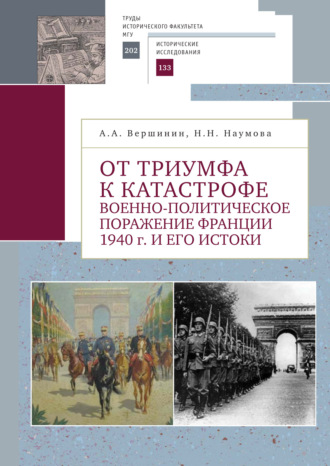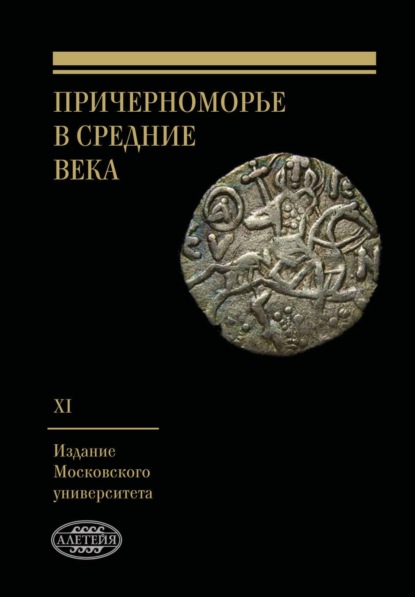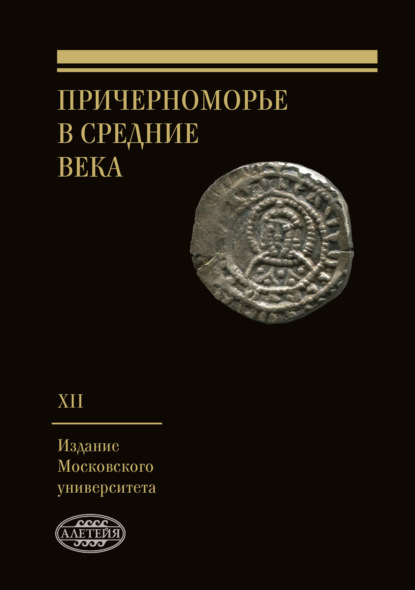
Полная версия
От триумфа к катастрофе. Военно-политическое поражение Франции 1940 г. и его истоки
84
Vergez-Chaignon B. Pétain, p. 216.
85
Doughty R. A. The Seeds of Disaster, p. 23.
86
Debeney M.-E. Sur la sécurité militaire de la France, p. 28.
87
Doughty R. A. The Seeds of Disaster, p. 23.
88
Цит. по: Kiesling E. C. ‘If It Ain’t Broke, Don’t Fix It’: French Military Doctrine Between the World Wars // War in History, April 1996, vol. 3, no. 2, p. 211.
89
Магадеев И. Э. Оценка германской угрозы французскими военными в 1920-е годы // Военно-исторический журнал, 2011, № 8, с. 57–58.
90
KieslingE. C. ‘If It Ain’t Broke, Don’t Fix It’: French Military Doctrine Between the World Wars, p. 214.
91
Doise J., Vaïsse M. Diplomatie et outil militaire, p. 351.
92
Weygand M. How France is Defended // International Affairs, 1939, vol. 18, no. 4, p. 460–461.
93
Цит. по: Doughty R. A. The Seeds of Disaster, p. 17.
94
La France militaire. 1929. 5 fév.
95
Kaufmann J. E., Kaufmann H. W. Fortress France. The Maginot Line and French Defenses in World War II. Westport, Conn., 2006, p. 3.
96
Hughes J. M. To the Maginot Line, p. 193.
97
Pétain P. La sécurité de la France au cours des années creuses // Revue des deux mondes, 1935, 1 mars.
98
Journal officiel de la République française. Débats parlementaires. Chambre des députés. 1922. 2 mars.
99
От фр. Chambre bleu-horizon. Шинели серо-голубого цвета являлись частью обмундирования французской армии.
100
Guelton F. Penser la guerre après 1919, p. 124.
101
Roussellier N. Le Parlement de l’éloquence. La souveraineté de la délibération au lendemain de la Grande Guerre. Paris, 1997, p. 98.
102
Арон Р. История ХХ века. Антология. М., 2007, с. 92.
103
Prost A. Les Anciens Combattants, 1914–1940. Paris, 1977, p. 66.
104
Sauvy A. Histoire économique de la France entre les deux guerres. Vol. 2: de Pierre Laval à Paul Reynaud. Paris, 1967, p. 322.
105
Bard C. Les Filles de Marianne: histoire des féminismes, 1914–1940. Paris, 1995, p. 135–141.
106
Siegel M. L. The Moral Disarmament of France: Education, Pacifism, and Patriotism, 1914–1940. New York, 2004.
107
Crémieux-Brilhac J.-L. Les Français de l’an 40. Vol. 1: La guerre, oui ou non? Paris, 1990, p. 90.
108
Фр. Section française de l’internationale Ouvrière (SFIO).
109
Арон Р. Мемуары. 50 лет размышлений о политике. М., 2002, с. 68–69.
110
Голль Ш. де. На острие шпаги. М., 2006, с. 16–17.
111
Journal officiel de la République française. Débats parlementaires. Chambre des députés. 1924. 17 juin.
112
Unger G. Aristide Briand. Le ferme conciliateur. Paris, 2005, p. 349–352.
113
Hughes J. M. To the Maginot Line, p. 94.
114
Троцкий Л. Д. Э. Эррио, политик золотой середины // http://lib.ru/TROCKU/
Arhiv_Trotskogo__t8.txt#20
115
Clemenceau G. Correspondance (1858–1929). Paris, 2008, p. 943.
116
Jackson P. Beyond the Balance of Power. France and the Politics of National Security in the Era of the First World War. Cambridge, 2013, p. 362.
117
Вершинин А. А. Аристид Бриан. Политический портрет государственного деятеля и дипломата Франции // Новая и новейшая история, 2017, № 1, с. 193.
118
Crémieux-Brilhac J.-L. Les Français de l’an 40. Vol. 1, p. 84.
119
Le Temps. 1925. 21 oct.
120
Цит. по: Doise J., Caisse M. Diplomatie et outil militaire, p. 343.
121
Цит. по: Jackson P. Beyond the Balance of Power, p. 487.
122
Weygand M. Mémoires. Vol. 2, Mirages et réalité. Paris, 1957, p. 329.
123
Вершинин А. А. Аристид Бриан, с. 195.
124
Doise J., Vaïsse M. Diplomatie et outil militaire, p. 364.
125
Горохов В. Н. История международных отношений, с. 123.
126
Jackson P. The failure of diplomacy, 1933–1940 // R.J.B. Bosworth, J. Maiolo (ed.). The Cambridge History of the Second World War: Volume 2, Politics and Ideology. Cambridge, 2015, p. 221.
127
Jackson P. Beyond the Balance of Power, p. 514.
128
Soutou G.-H. Réflexions sur l’échec de la sécurité collective et ses raisons // Transversalités, 2011, vol. 3, no. 119, p. 179–180.
129
Магадеев И. Э. Первая мировая война и тренды европейской истории ХХ века. М., 2021, с. 67–68.
130
Documents diplomatiques français, 1932–1939. 2-série (1936–1939). T. 13. Paris, 1979, p. 456.
131
Crémieux-Brilhac J.-L. Les Français de l’an 40. Vol. 1, p. 116.
132
Цит. по: МагадеевИ. Э. Фердинанд Фош, с. 11.
133
Guelton F. Penser la guerre après 1919, p. 125.
134
Hughes J. M. To the Maginot Line, p. 86–87.
135
Цит. по: Vergez-Chaignon B. Pétain, p. 217.
136
Debeney M.-E. La Guerre et les hommes: réflexions d’après-guerre. Paris, 1937, p. 205.
137
Alexander M. S. In defence of the Maginot line. Security policy, domestic politics and the economic depression in France // R. Boyce (ed.). French Foreign and Defense Policy, p. 168.
138
Vergez-Chaignon B. Pétain, p. 218.
139
Цит. по: Doise J., VaïsseM. Diplomatie et outil militaire, p. 342–343.
140
F. Guelton (dir.). Journal du Général Edmond Buat, p. 1266.
141
Doughty R. A. The Seeds of Disaster, p. 51.
142
Цит. по: Sarmant T. Les plans d’opération français en Europe centrale, p. 14.
143
Doughty R. A. The Seeds of Disaster, p. 54.
144
Garraud P. La politique de fortification des frontières de 1925 à 1940: logiques, contraintes et usages de la «ligne Maginot» // Guerres mondiales et conflits contemporains, 2007, no. 226, p. 6–7.
145
Цит. по: Sarmant T. Les plans d’opération français en Europe centrale, p. 14.
146
Doughty R. A. The Seeds of Disaster, p. 52–53.
147
Weygand M. Mémoires, p. 320.
148
F. Guelton (dir.). Journal du Général Edmond Buat, p. 1266.
149
Garraud P. La politique de fortification des frontières de 1925 à 1940, p. 8.
150
Doughty R. A. The Seeds of Disaster, p. 61.
151
Journal officiel de la République française. Débats parlementaires. Chambre des députés. 1929. 10 déc.
152
Имеется в виду Международная конференция по разоружению, открывшаяся в 1932 г. в Женеве
153
Alexander M. S. In defence of the Maginot line, p. 177.
154
Sorlot M. Les entourages militaires d’André Maginot dans les années 1920, p. 148.
155
Fabry J. De la place de la Concorde au cours de l’intendance (février 1934 – juin 1940). Paris, 1942, p. 29.
156
Weygand M. Mémoires, p. 320–321.
157
Debeney M.-E. La Guerre et les hommes, p. 205–206.
158
Culmann F. Tactique d’artillerie. Paris, 1937, p. 365–366.
159
Debeney M.-E. La Guerre et les hommes, p. 152.
160
Cochet F. La Grande Guerre: quatre années d’une révolution militaire, 1914–1918 // H. Drévillon, O. Wieviorka (dir.). Histoire militaire de la France, p. 201.
161
Doughty R. A. French Operational Art: 1888–1940 // M. D. Krause, R. C. Phillips (ed.). Historical Perspectives of the Operational Art. Washington, 2005, p. 88.
162
Pétain H.-P. La bataille de Verdun. Paris, 1941, p. 143–154.
163
Doise J., Vaïsse M. Diplomatie et outil militaire, p. 341–342.
164
Doughty R. A. French Operational Art, p. 91.
165
Guelton F. Penser la guerre après 1919, p. 132.
166
Cochet F. La Grande Guerre. Paris, 2018, p. 472.
167
Cochet F. La Grande Guerre: quatre années d’une révolution militaire, p. 234.
168
Young R. J. The Strategic Dream: French Air Doctrine in the Inter-War Period, 19191939 // Journal of Contemporary History, 1974, vol. 9, no. 4, p. 56.
169
Chagnon L. 1916 ou l’année de rupture en matière d’utilisation de l’arme aérienne // Revue historique des armées, 2006, no. 242, p. 5.
170
Cochet F. La Grande Guerre: quatre années d’une révolution militaire, p. 241.
171
Cochet F. La Grande Guerre, p. 472–473.
172
Bond B., Alexander M. Liddel Hart and De Gaulle: The Doctrines of Limited Liability and Mobile Defense // P. Paret (ed.). Makers of Modern Strategy from Machiavelli to the Nuclear Age. Princeton, 1986, p. 603.
173
Estienne J.-B. Préface // Murray Wilson G. Les chars d’assaut au combat, 1916–1919. Paris, 1931, p. 14–15.
174
Pigeaud M.-C. L’arme de la sûreté // Revue militaire française, mars 1923, vol. 7, p. 403–404.
175
André M. Dans l’ombre de Charles de Gaulle: pionniers des chars et autres «prêcheurs» militaires français oubliés de l’arme blindée dans l’entre-deux-guerres // Stratégique, 2015, vol. 2, no 109, p. 219.
176
Российским историкам генерал Думенк больше известен как глава французской военной миссии на трехсторонних военных англо-франко-советских переговорах в Москве в августе 1939 г.
177
Porte R. Le général d’armée Doumenc, logisticien et précurseur de l’arme blindée // Cahiers du CESAT, mars 2010, no. 19, p. 7.
178
Doumenc J.-A. La défense des frontières: leçons des maîtres disparus // Revue militaire française, vol. 37, oct. 1930, p. 27–28.
179
Carlier C. Le destin manqué de l’aéronautique française // G. Pedroncini (dir.). Histoire militaire de la France. T. III (de 1871 à 1940). Paris, 1992, p. 407.
180
Young R. J. The Strategic Dream: French Air Doctrine in the Inter-War Period, p. 60–61.
181
Guelton F. Penser la guerre après 1919, p. 125.
182
Wieviorka O. Démobilisation, effondrement, renaissance, p. 327–339.
183
Rapport fait au nom de la Commission chargée d’enquêter sur les événements survenus en France de 1933 à 1945. Vol. 1. Paris, 1951, p. 192.
184
Jacomet R. L’Armement de la France: 1936–1939. Paris, 1945, p. 92–93.
185
Ibid., p. 89.
186
Carlier C. Le destin manqué de l’aéronautique française, p. 408.
187
Wieviorka O. Démobilisation, effondrement, renaissance, p. 327.
188
Dutailly H. Les illusions de la victoire, 1918–1930 // G. Pedroncini (dir.). Histoire militaire de la France, p. 331.
189
Doughty R. A. The Seeds of Disaster, p. 61.
190
BondB., Alexander M. Liddel Hart and De Gaulle: The Doctrines of Limited Liability and Mobile Defense, p. 604.
191
Wieviorka O. Démobilisation, effondrement, renaissance, p. 327.
192
Gamelin M. Servir. Vol.2. Paris, 1946, p. 10.
193
Weygand M. How France is Defended, p. 474.
194
См. подробнее: Corum J. S. The Roots of Blitzkrieg: Hans von Seeckt and German Military Reform. Lawrence, 1994.
195
Doise J., Caisse M. Diplomatie et outil militaire, p. 339.
196
Цит. по: Le Groignec J. Pétain et De Gaulle. Paris, 1998, p. 72.
197
Vergez-Chaignon B. Pétain, p. 219.
198
Wieviorka O. Démobilisation, effondrement, renaissance, p. 339.
199
Doise J., Vaïsse M. Diplomatie et outil militaire, p. 346.
200
Guelton F. Les hautes instances de la Défense nationale sous la Troisième république // O. Forcade, E. Duhamel, P. Vial (ed.). Militaires en république, 1870–1962, p. 59.
201
Nobécourt J. Une histoire politique de l’armée. Vol. 1: De Pétain à Pétain, 1919–1942. Paris, 1967, p. 183–184.
202
Свечин А. А. Стратегия. М., 1926, с. 158.
203
Jackson P. Beyond the Balance of Power, p. 472.
204
Doise J., Vaïsse M. Diplomatie et outil militaire, p. 337.
205
Магадеев И. Э. В тени Первой мировой войны: Дилеммы европейской безопасности в 1920-е годы. М., 2021, с. 508–511.
206
Schramm T., BulhakH. La France et la Pologne 1920–1922: Relations bilatérales ou partie d’un système européen de sécurité? // Guerres mondiales et conflits contemporains, 1999, no. 193, p. 44–45; Nieuwazny A. Ferdinand Foch et la Pologne // F. Cochet, R. Porte (dir.). Ferdinand Foch (1851–1929): apprenez à penser, p. 408–411.
207
Арон Р. История ХХ века, с. 89.
208
Голль Ш. де. На острие шпаги, с. 17–18.
209
Сидоров А. Ю. Клейменова Н. Е. История международных отношений 19181939 гг. М., 2008, с. 161–166.
210
Mommsen H. The Rise and Fall of Weimar Democracy. Chapel Hill and London, 1996, p. 221.
211
Патрушев А. И. Германская история: через тернии двух тысячелетий. М., 2007, с. 396.
212
Berstein S., Milza P. Histoire de la France au XXe siècle. T. 1: 1900–1930. Paris, 2004, p. 372.
213
См. подробнее: Corum J. S. The Roots of Blitzkrieg, p. 74.
214
Ватлин А. Ю. Германия в ХХ веке. М., 2005, с. 408.
215
Фест И. Гитлер. Биография. Путь наверх. М., 2009, с. 473.
216
Туз А. Цена разрушения. Создание и гибель нацистской экономики. М., 2019, с. 46.
217
Патрушев А. И. Германская история, с. 413.
218
Mommsen H. The Rise and Fall of Weimar Democracy, p. 393.
219
Le Temps. 1930. 12 sept.
220
Jackson P. The failure of diplomacy, 1933–1940, p. 242.
221
Gamelin M. Servir. Vol. 2, p. 56.
222
Локарнская конференция 1925 г. Документы. М., 1959, с. 298.
223
А.З. Манфред (ред.). История Франции, с. 138–139.
224
Santamaria Y. Le pacifisme, une passion française. Paris, 2005.
225
Merlio G. Le pacifisme en Allemagne et en France entre les deux guerres mondiales // Les cahiers Irice, 2011, no. 8, p. 52–53.
226
Doise J., VaïsseM. Diplomatie et outil militaire, p. 353. Задача сокращения военных расходов по итогам реформ 1927–1928 гг. так и не была выполнена. Напротив, реорганизация управления армией, привлечение дополнительных контингентов профессиональных военных привели к росту затрат за сухопутные силы на 2,6 миллиарда франков между 1927 и 1931 гг. (см. Ibidem.).






